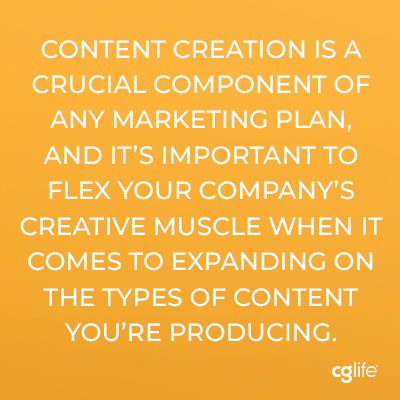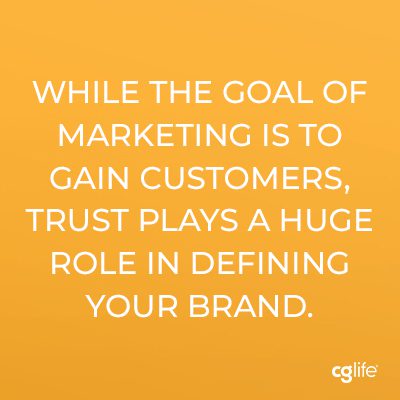With the recent uptick of COVID-19 infections around the world, 2022 is shaping up to be another year of unpredictability and social distancing. According to Salesforce, 88% of customers expect companies to accelerate their digital initiatives because of the pandemic. We feel the same way. With the ever-changing landscape, 2022 marketing trends will likely lean heavily on communication through technology and digital content creation.
As you begin your annual planning, these are a few key areas to take into consideration for developing your company’s marketing strategy and budget. We bugged our multi-disciplinary team for some of their top picks and areas to invest in.
The Cookies are Crumbling
The death of the third-party cookie is quickly approaching. In June, Google announced that it will now phase out support for third-party cookies in its Chrome browser in mid to late 2023. Chrome currently possesses around 65% of all browser market share. While this is a slight delay from the original deadline of Q1 2022, it’s still a HUGE deal for digital advertising. The decision will fundamentally change how users are tracked across the web, the foundation for the significant majority of advertising revenue.
In this new world, first-party data is going to be more valuable than ever. Companies will need to 1) optimize their existing CRM data to power their marketing funnel and 2) maximize their marketing automation tools to collect additional first-party information. The race to replace the information captured through tracking cookies is on. Beyond marketing automation, companies will need to quickly adjust to new tech and platforms to maximize their digital ad spend
Content is Your Elected Leader
White papers, webinars, infographics… oh my! According to a HubSpot survey, 70% of marketers actively invested in their content marketing in 2020/21. Content creation is a crucial component of any marketing plan, and it’s important to flex your company’s creative muscle when it comes to expanding on the types of content you’re producing. In the same report, videos, blogs, and eBooks were the top three areas of content that the surveyed companies focused heavily on.

In today’s digital age, consistently producing diverse content across your company’s channels (website, social media, e-mail marketing, etc.) will drive greater engagement and reach.
But don’t let strong content marketing end with your marketing plan! As paid campaigns adjust to a post-cookie future, organic search is going to be more valuable than ever. That is now transitioning directly into content selling strategies, which emphasize a clear content strategy that directly supports the sales journey. This will be a vital part of a strong sales enablement strategy, integrating the two fields. Socially savvy sales teams can become content curators, creating, and sharing internally and externally sourced collateral to start new conversations with prospects.
Digital High-Fives and Handshakes
With the surge of new variants, companies need to think outside the box when it comes to hosting events, meetings, and conferences. In 2020, companies that relied heavily on events as a key sales and marketing tool had to quickly pivot their programming to entirely virtual. Now, events are evolving into a hybrid approach, opening their doors to in-person meetings while still welcoming virtual attendees. Done well, this can create a more inclusive environment for all.
For success, a lot of thought should go into the technology your company uses for hosting a virtual or hybrid event. Above all else, the platform should be secure and user-friendly. Communicate beforehand with your attendees so they know how to maximize its features. This can be done through email marketing, live chat options, and video demos. With the lack of face-to-face connection, it’s important to come up with ideas for your audience to network with speakers and other attendees. These could include interactive digital panels, live social media Q&As, and messaging throughout live presentations.
Incorporating shared experiences into your hybrid event can also provide additional networking and connection opportunities. For their most recent conference, The American Society of Association Executives created “Community Pop-UP” gatherings in various cities, that provided at least one in-person presentation at each location. This allowed attendees in those areas to participate while still connecting virtually with others in different locations.
Gather Around the Digital Campfire
While social media is still seeing robust growth, younger audiences are spending more and more time around “digital campfires,” creating interactive and virtual huddles on platforms such as Fortnite, Discord, and Twitch. Here, the focus changes from a carefully curated social media presence to authentic communities tied to shared interests. These users can more freely be themselves, with enhanced privacy, safety, and an escape from the presence of other people on social platforms (aka in-laws). B2C brands are already taking advantage of these spaces but there is value for B2B life science and healthcare companies as well. Closed LinkedIn groups are just one example, where more niche and fruitful conversations can be had in a semi-private forum. The key in all these communities is to engage as an individual. A corporate account doesn’t blend in, so you’ll need to prime your experts and sales folks to contribute as individuals.
AI, Captain!
Recent research by Salesforce found 83% of customers expect immediate engagement when they contact a company. With various components to artificial intelligence, the technology is being used more frequently to keep up with customer demands. AI tools, including voice assistants and chatbots, help businesses respond and interact in real-time, even if they are automated.
In the same study, 66% of customers expect companies to tailor content to their specific needs and expectations, although the same percentage stated they don’t feel seen or understood by the companies’ marketing messaging. With the ability of AI to analyze user behaviors, companies can enhance a customer’s experience by customizing and personalizing content – from targeted emails to chatbot features.
Trust is a Must
While the goal of marketing is to gain customers, trust plays a huge role in defining your brand. One way trust can be built is through thought leadership. Thought leadership is less about selling your brand, and more about showing others your expertise in a specific field. In this LinkedIn thought leadership piece, Illumina CEO Francis deSouza discusses the role genomics played throughout 2020, specifically in the COVID-19 pandemic. Gaining insight about a company through an individual’s point of view, instead of a collective company voice can often be seen as a more genuine and personal approach to conveying an overall message.

User-generated content is another rising trend, tied to trust and perceived neutrality. With technology and social media at the tips of our fingers, each one of us can tell a story. According to a study by Bright Local, online reviews are trusted by a whopping 91% of customers between the ages of 18 and 34. In the end, we’re all humans and user-generated content, including customer reviews and influencer marketing, provides a better sense of relatability and authenticity to customers.
2022, We’re Ready for You!
In an incessantly connected world, marketing trends will continue to center around the ability to attract, engage, and learn through digital platforms and technology. We’ve got you covered on that front. From paid media to content creation, public relations to graphic design, we can design and power your marketing needs for 2022 and beyond. Just give us a shout!
